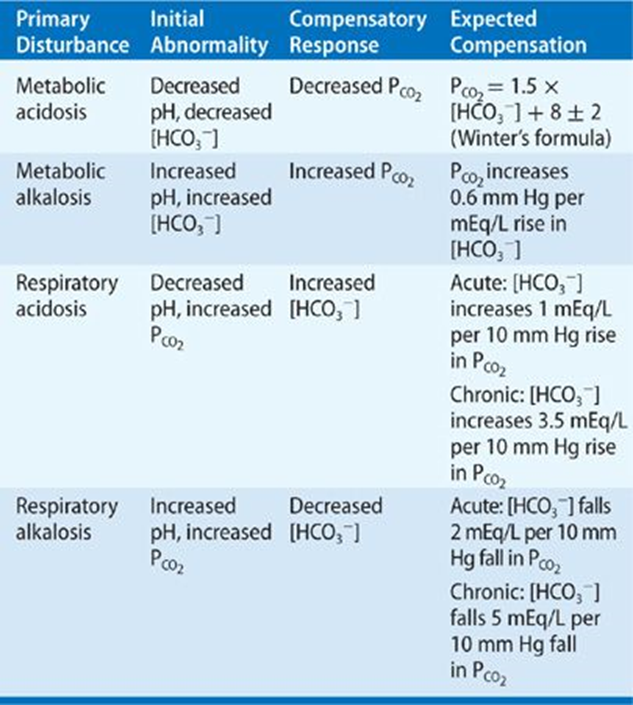A nurse reviews the arterial blood gas (ABG) values of a client admitted with pneumonia: pH, 7.32; PaCO2, 48 mm Hg; PaO2, 70 mm Hg; and HCO3, 24 mEq/L. What do these values indicate?
Metabolic Acidosis
Respiratory Acidosis
Metabolic Alkalosis
Respiratory Alkalosis
The Correct Answer is B
A. Metabolic Acidosis
Metabolic acidosis is characterized by a low pH and low bicarbonate (HCO3) level. In this case, the pH is low (indicating acidosis), but the bicarbonate level is within the normal range, which is inconsistent with metabolic acidosis.
B. Respiratory Acidosis
This is correct. Respiratory acidosis is characterized by an elevated partial pressure of carbon dioxide (PaCO2), leading to a decrease in pH. The ABG values in this case indicate elevated PaCO2 and a low pH, consistent with respiratory acidosis.
C. Metabolic Alkalosis
Metabolic alkalosis is characterized by a high pH and high bicarbonate (HCO3) level. In this case, the pH is low (indicating acidosis), which is inconsistent with metabolic alkalosis.
D. Respiratory Alkalosis
Respiratory alkalosis is characterized by a low partial pressure of carbon dioxide (PaCO2) and a high pH. In this case, the PaCO2 is elevated, which is inconsistent with respiratory alkalosis.

Nursing Test Bank
Naxlex Comprehensive Predictor Exams
Related Questions
Correct Answer is A
Explanation
A. "If a vial of insulin will be used up within 21 days, it may be kept at room temperature."
This statement suggests a duration of up to 21 days for room temperature storage after the vial is in use. However, most insulins can typically be stored at room temperature for up to 28 days after initial use. This recommendation might be more conservative than necessary for many types of insulin.
B. "If a vial of insulin will be used up within 2 weeks, it may be kept at room temperature."
This choice suggests a timeframe of 14 days for room temperature storage after opening the vial. However, for many insulins, the recommended duration for room temperature storage after opening is up to 28 days.
C. "If you are going to use up the vial within 1 month, it can be kept at room temperature."
This option extends the timeframe to 1 month for room temperature storage after the vial is in use. However, the generally recommended duration for many insulins is up to 28 days after opening.
D. "If a vial of insulin will be used up within 1 week, it may be kept at room temperature."
This choice suggests a very short duration of 7 days for room temperature storage after opening the vial. Most insulins can typically be stored at room temperature for a longer duration after initial use.
Correct Answer is B
Explanation
A. "The test needs to be repeated following a 12-hour fast."
This statement is not accurate. The hemoglobin A1c test does not require fasting. It reflects the average blood glucose levels over the past two to three months and is not affected by short-term changes in diet or fasting.
B. "It tells us about your sugar control for the last 3 months."
This statement is accurate. The hemoglobin A1c test provides information about the average blood glucose levels over the past two to three months. It's a valuable tool for assessing long-term glycemic control.
C. "It looks like you aren't following the prescribed diabetic diet."
The hemoglobin A1c test reflects overall glycemic control over several months and is not solely influenced by recent dietary habits. While diet plays a role in diabetes management, this statement oversimplifies the interpretation of the A1c result.
D. "Your insulin regimen needs to be altered significantly."
While a high A1c may indicate a need for adjustments in the treatment plan, the decision to alter the insulin regimen should be based on a comprehensive assessment of the patient's overall diabetes management, including lifestyle, diet, and other factors. It may not solely be determined by the A1c result.
Whether you are a student looking to ace your exams or a practicing nurse seeking to enhance your expertise , our nursing education contents will empower you with the confidence and competence to make a difference in the lives of patients and become a respected leader in the healthcare field.
Visit Naxlex, invest in your future and unlock endless possibilities with our unparalleled nursing education contents today
Report Wrong Answer on the Current Question
Do you disagree with the answer? If yes, what is your expected answer? Explain.
Kindly be descriptive with the issue you are facing.
